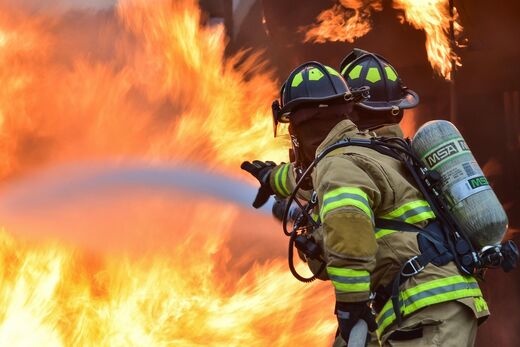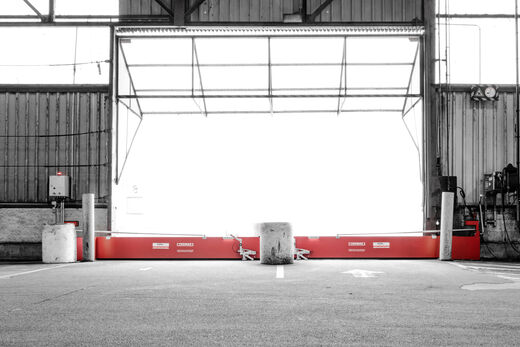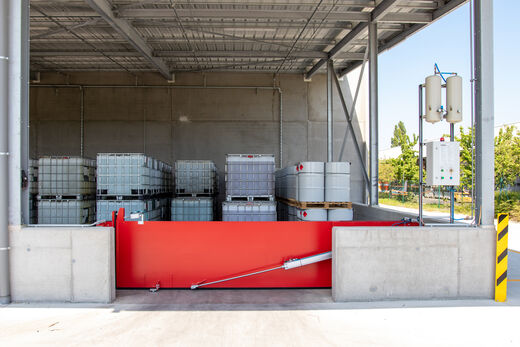Firewater containment legislation

What is firewater containment?
Firewater containment is the collection of firewater that was contaminated with hazardous substances.
Firewater containment is crucial to prevent contaminated firewater from damaging both the environment (watercourses, soil, public sewers) and adjacent spaces and buildings. In accordance with legislation VLAREM II, every classified establishment must have a firewater containment system.
Doorway spill barriers are specifically designed to make an entire site or certain parts (e.g. doorways, gates or passages) liquid-tight.
With more than 30 years of experience, CGK is a specialist in installing spill barriers. We searched for the best solution to collect fire water, contain hazardous liquids or prevent flooding.

How to collect firewater?
In industrial buildings, the following forms of firewater collection may be present:
- underground buffer basin,
- bulkheads on doors and gates closing, also called firewater barriers.
- temporary storage in sewer system provided sewer sealers are used,
- ramps in warehouses or unloading docks.
All these collection facilities must have a liquid-tight floor.
Firewater barriers
Our barriers are a liquid-proof system that does not disturb the internal movement of people or vehicles. Automatic barriers close when a leak or fire is detected. In fire-fighting operations, these barriers prevent contaminated fire-fighting water or hazardous products from entering sewers or unpaved soil. Applications of liquid barriers include:
- Collection of firewater
- Containment of hazardous liquids in storage spaces (with or without racks) where chemical products are transferred.
- Liquid compartmentalisation of production areas
- Industrial flood protection for businesses, warehouses, underground car parks
- ...
CGK is responsible for the analysis, production, supply, installation and maintenance of all firewater containment applications.
The use of manual or automatic spill barriers (water baffles/liquid barriers) to contain leaks, contaminated fire-fighting water or water from sprinkler systems in commercial buildings is becoming increasingly common. Barriers or water baffles allow already existing buildings serving as storage or production areas to be equipped according to current environmental standards. Liquid barriers are also increasingly taken into account in the design phase of new buildings.
Benefits of spill barriers
- Preventing soil contamination and high soil remediation costs
- Can be installed in existing as well as new buildings
- Preventing damage to surrounding spaces and installations
- Are linkable to Fixed Fire Protection and Fire Fighting Systems
Compliance with legislation and inspections
CGK has already installed thousands of barriers worldwide, all manufactured and approved according to German guidelines VdS n°G6080001. Our barriers are CE et TÜV compliant (DIN EN ISO 9001 no. v/h certificate 151009651) and installation is done by technicians working in compliance with TÜV. There is an FM approval on various types.
More tips & legislation can be found at the bottom of this webpage.
Types of barriers
- Automatic barriers (Automatic barriers)
- Manual barriers (manual closing and opening)
- Fixed barriers (liquid-tight zone)
- FM approved barriers (fire resistant)
- Sewer sealers and manhole sealers (automatic or manual)
CGK Group: quality and service
- Employees with many years of experience
- Installation is carried out by our own technicians
- Produced with high-quality materials and accessories (Thomas GmbH)
- The barriers are custom-made according to the application (indoor/outdoor, specific chemical products, etc.)
- EPDM or VITON seals (optional)
Want to know more about our spill barriers?
Get all the information or request a no-obligation quote.
Tips & regulations
Firewater containment and legislation VLAREM II (B) and PGS15 (NL)/PGS14 (NL)
CGK's barriers comply with Belgian, Dutch and European legislation. To capture as much potentially contaminated fire fighting water as possible, it is necessary to collect as much fire fighting water as possible at the site itself. Our barriers are the ideal means to contain the contaminated water. Of course, the floors and walls must also be impermeable. Our systems are compliant with VLAREM II and PGS15/PGS14.
Legislation in the Netherlands
- PGS 15:2016 and NFPA 30:2015 distinguish between product and firewater collection, on the one hand, and facilities that prevent burning liquid from leaking into adjacent storage compartments, on the other.
- The PGS14 (2017) provides guidance to further explain the PGS15.
- To prevent liquids from leaking into adjacent storage bays, barriers (barrier - or guillotine principle ) are mentioned as a solution.
- Besides these barriers, there are also solutions to close the sewer in case of emergencies.
Calculating firewater collection
The height of barriers depends on the amount of extinguishing water you need to collect.
